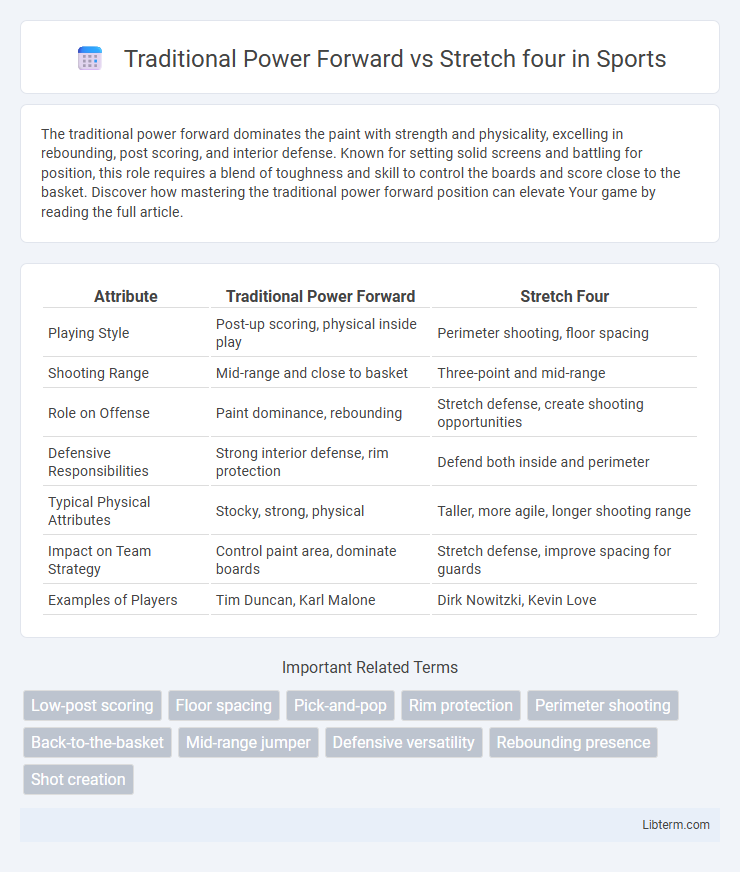The traditional power forward dominates the paint with strength and physicality, excelling in rebounding, post scoring, and interior defense. Known for setting solid screens and battling for position, this role requires a blend of toughness and skill to control the boards and score close to the basket. Discover how mastering the traditional power forward position can elevate Your game by reading the full article.
Table of Comparison
| Attribute | Traditional Power Forward | Stretch Four |
|---|---|---|
| Playing Style | Post-up scoring, physical inside play | Perimeter shooting, floor spacing |
| Shooting Range | Mid-range and close to basket | Three-point and mid-range |
| Role on Offense | Paint dominance, rebounding | Stretch defense, create shooting opportunities |
| Defensive Responsibilities | Strong interior defense, rim protection | Defend both inside and perimeter |
| Typical Physical Attributes | Stocky, strong, physical | Taller, more agile, longer shooting range |
| Impact on Team Strategy | Control paint area, dominate boards | Stretch defense, improve spacing for guards |
| Examples of Players | Tim Duncan, Karl Malone | Dirk Nowitzki, Kevin Love |
Defining the Traditional Power Forward
The traditional power forward, often known as the "four," is a basketball player who excels in physicality, rebounding, and interior defense, typically playing close to the basket. Emphasizing strength and post moves, these players dominate the paint on both offense and defense while often setting screens and securing boards. Unlike stretch fours, traditional power forwards rarely shoot beyond the three-point line, focusing instead on mid-range jumpers and close-range scoring opportunities.
What is a Stretch Four in Modern Basketball?
A Stretch Four in modern basketball is a power forward who extends their shooting range beyond the traditional paint area, often hitting three-pointers to create spacing and open driving lanes. Unlike a traditional power forward, who primarily operates near the basket for rebounds and post moves, a Stretch Four combines size with perimeter shooting and floor spacing versatility. This role is crucial in contemporary offenses that emphasize pace and space, allowing teams to exploit mismatches and increase scoring opportunities from the perimeter.
Key Skills: Inside Presence vs Perimeter Shooting
Traditional power forwards excel in inside presence with strong post moves, rebounding, and physical defense near the basket, dominating the paint on both ends. Stretch fours prioritize perimeter shooting, often extending defenses by hitting three-pointers and creating spacing, while still contributing as capable rebounders and defenders. The key skill difference lies in the traditional power forward's emphasis on paint scoring and interior toughness versus the stretch four's ability to stretch the floor with consistent outside shooting.
Rebounding and Defense: Classic Strengths vs New Demands
Traditional power forwards excel in rebounding and interior defense, utilizing their size and strength to control the paint and secure second-chance opportunities. Stretch fours face new demands by balancing perimeter shooting with defensive versatility, often guarding multiple positions while still contributing to rebounding. This shift requires enhanced agility and lateral quickness to counter quicker players, challenging the conventional power forward's role.
Impact on Team Offense and Spacing
Traditional power forwards excel in interior scoring and rebounding, providing a strong post presence that anchors the team's inside offense. Stretch fours, by contrast, extend the defense with reliable perimeter shooting, creating spacing that opens driving lanes for guards and bigs alike. This enhanced floor spacing from stretch fours enhances ball movement and offensive versatility, increasing scoring opportunities across the team.
Role Evolution: How NBA Tactics Have Shifted
Traditional power forwards dominated the NBA with physical post play, rebounding, and interior defense, anchoring teams in the paint. The rise of the stretch four marks a tactical evolution, emphasizing perimeter shooting, floor spacing, and versatility to counter increasingly pace-and-space offensive systems. This shift reflects broader changes in NBA strategies, where big men must now combine size with shooting range and agility to thrive.
Notable Examples: Legendary Power Forwards vs Iconic Stretch Fours
Karl Malone and Tim Duncan exemplify legendary traditional power forwards, known for dominating the paint with physicality and rebounding prowess. Dirk Nowitzki and Kevin Durant are iconic stretch fours, revolutionizing the position by combining size with exceptional outside shooting and floor spacing. These players highlight the evolution from interior strength to perimeter versatility in the power forward role.
Matchup Challenges: Exploiting Opponent Weaknesses
Traditional power forwards excel in physical post play, using strength and rebounding to dominate inside, posing matchup challenges for opponents lacking interior defense. Stretch fours extend floor spacing by shooting reliably from beyond the arc, forcing slower, paint-bound defenders to contest perimeter shots and open driving lanes. Exploiting opponent weaknesses depends on leveraging the power forward's inside presence against smaller defenders or the stretch four's shooting against slower bigs unable to guard on the perimeter.
Draft and Development: What Coaches Look For
Coaches prioritize traditional power forwards with strong rebounding, post moves, and interior defense, valuing physicality and toughness during drafts and player development. Stretch fours are sought for their ability to space the floor with consistent three-point shooting and versatile perimeter defense, reflecting the NBA's shift to a faster pace and floor spacing. Development programs emphasize improving shooting range and agility for stretch fours, while traditional power forwards focus on strength, paint presence, and mid-range scoring.
The Future: Will Stretch Fours Replace Traditional Power Forwards?
Stretch fours excel in floor spacing and perimeter shooting, aligning with modern analytics emphasizing three-point efficiency and pace. Traditional power forwards maintain dominance in rebounding, interior defense, and post scoring, essential for physical play and rim protection. The future likely favors stretch fours in pace-and-space offenses, though hybrid players blending traditional toughness with shooting versatility will define the evolving power forward role.
Traditional Power Forward Infographic

 libterm.com
libterm.com